Case Study: Object Modeling and Design of Collin’s ATM System
VerifiedAdded on 2023/06/13
|15
|3287
|387
Case Study
AI Summary
This case study provides a detailed object modeling and design analysis of Collin’s ATM system. It begins by outlining the functional and non-functional requirements of the ATM, followed by a use case diagram illustrating user interactions. A UML domain model class diagram is presented to depict the system's architecture. The report further explores the design activities within the Software Development Life Cycle (SDLC), including environment setup, application components (door lock, card reader, display, keypad, printer, money box), user interface considerations, database management, and software methods for fund transfer and transaction processing. The study concludes by emphasizing the importance of security measures and suggests SDLC as a framework for developing new ATM systems, highlighting the need for robust verification processes to prevent unauthorized access. Desklib provides access to similar solved assignments and past papers for students.
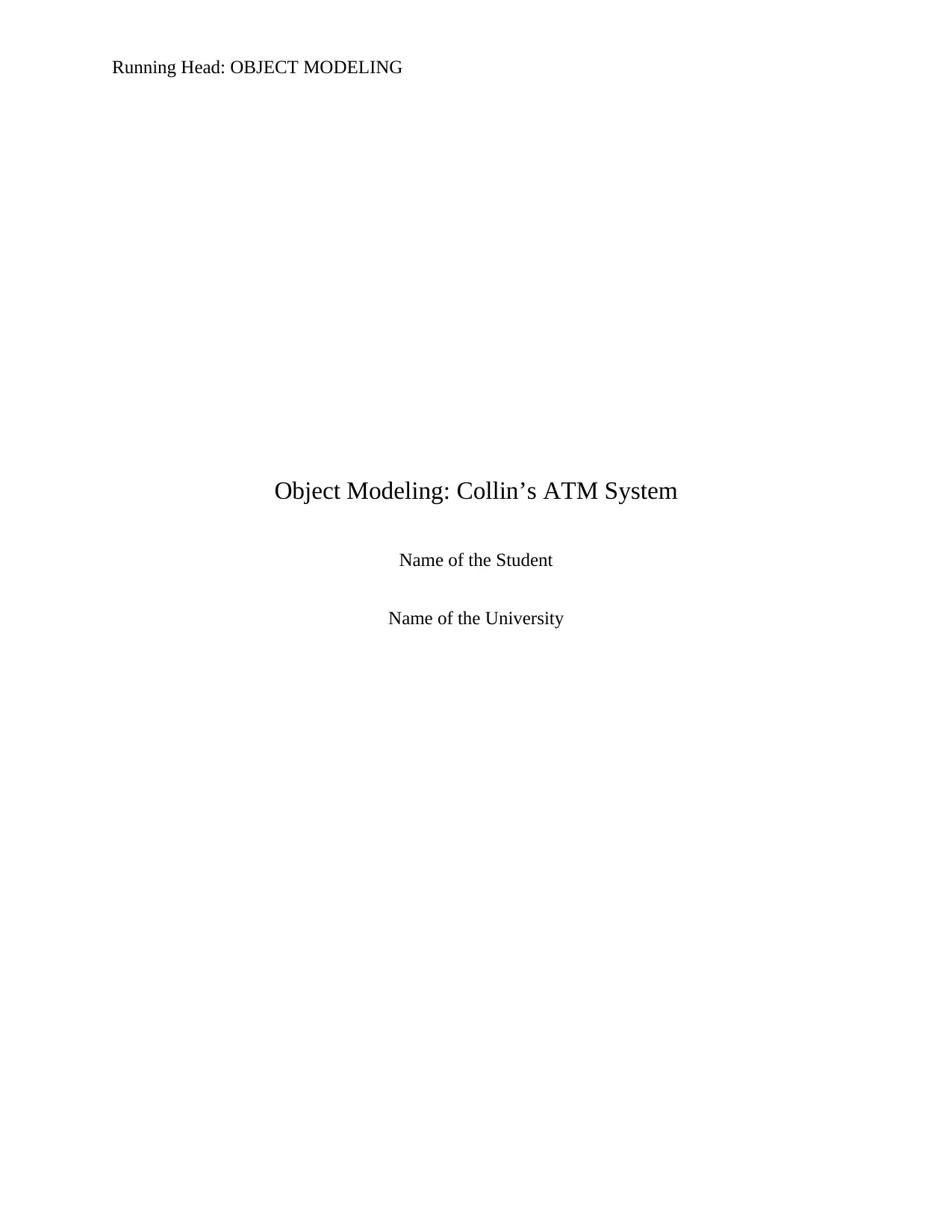
Running Head: OBJECT MODELING
Object Modeling: Collin’s ATM System
Name of the Student
Name of the University
Object Modeling: Collin’s ATM System
Name of the Student
Name of the University
Paraphrase This Document
Need a fresh take? Get an instant paraphrase of this document with our AI Paraphraser
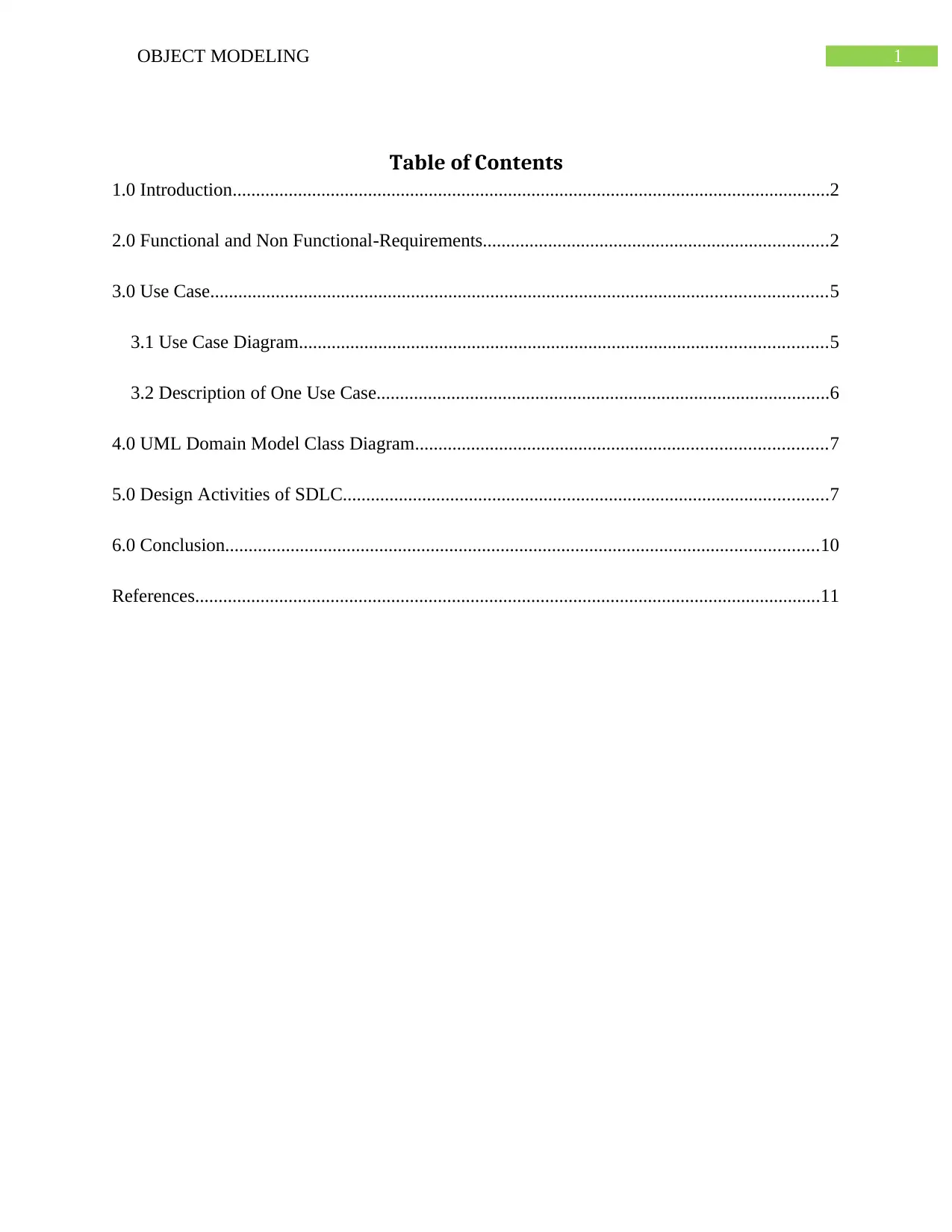
1OBJECT MODELING
Table of Contents
1.0 Introduction................................................................................................................................2
2.0 Functional and Non Functional-Requirements..........................................................................2
3.0 Use Case....................................................................................................................................5
3.1 Use Case Diagram.................................................................................................................5
3.2 Description of One Use Case.................................................................................................6
4.0 UML Domain Model Class Diagram........................................................................................7
5.0 Design Activities of SDLC........................................................................................................7
6.0 Conclusion...............................................................................................................................10
References......................................................................................................................................11
Table of Contents
1.0 Introduction................................................................................................................................2
2.0 Functional and Non Functional-Requirements..........................................................................2
3.0 Use Case....................................................................................................................................5
3.1 Use Case Diagram.................................................................................................................5
3.2 Description of One Use Case.................................................................................................6
4.0 UML Domain Model Class Diagram........................................................................................7
5.0 Design Activities of SDLC........................................................................................................7
6.0 Conclusion...............................................................................................................................10
References......................................................................................................................................11
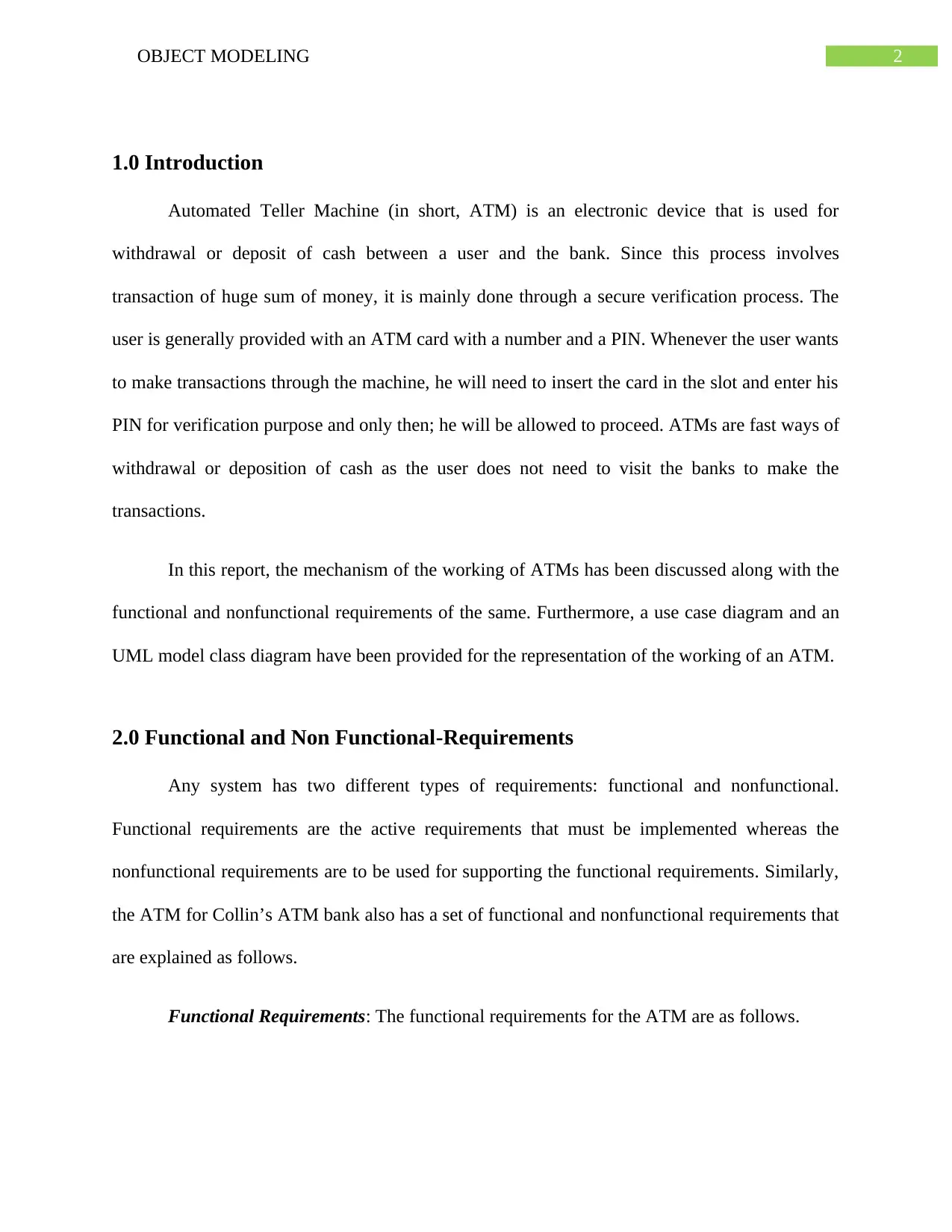
2OBJECT MODELING
1.0 Introduction
Automated Teller Machine (in short, ATM) is an electronic device that is used for
withdrawal or deposit of cash between a user and the bank. Since this process involves
transaction of huge sum of money, it is mainly done through a secure verification process. The
user is generally provided with an ATM card with a number and a PIN. Whenever the user wants
to make transactions through the machine, he will need to insert the card in the slot and enter his
PIN for verification purpose and only then; he will be allowed to proceed. ATMs are fast ways of
withdrawal or deposition of cash as the user does not need to visit the banks to make the
transactions.
In this report, the mechanism of the working of ATMs has been discussed along with the
functional and nonfunctional requirements of the same. Furthermore, a use case diagram and an
UML model class diagram have been provided for the representation of the working of an ATM.
2.0 Functional and Non Functional-Requirements
Any system has two different types of requirements: functional and nonfunctional.
Functional requirements are the active requirements that must be implemented whereas the
nonfunctional requirements are to be used for supporting the functional requirements. Similarly,
the ATM for Collin’s ATM bank also has a set of functional and nonfunctional requirements that
are explained as follows.
Functional Requirements: The functional requirements for the ATM are as follows.
1.0 Introduction
Automated Teller Machine (in short, ATM) is an electronic device that is used for
withdrawal or deposit of cash between a user and the bank. Since this process involves
transaction of huge sum of money, it is mainly done through a secure verification process. The
user is generally provided with an ATM card with a number and a PIN. Whenever the user wants
to make transactions through the machine, he will need to insert the card in the slot and enter his
PIN for verification purpose and only then; he will be allowed to proceed. ATMs are fast ways of
withdrawal or deposition of cash as the user does not need to visit the banks to make the
transactions.
In this report, the mechanism of the working of ATMs has been discussed along with the
functional and nonfunctional requirements of the same. Furthermore, a use case diagram and an
UML model class diagram have been provided for the representation of the working of an ATM.
2.0 Functional and Non Functional-Requirements
Any system has two different types of requirements: functional and nonfunctional.
Functional requirements are the active requirements that must be implemented whereas the
nonfunctional requirements are to be used for supporting the functional requirements. Similarly,
the ATM for Collin’s ATM bank also has a set of functional and nonfunctional requirements that
are explained as follows.
Functional Requirements: The functional requirements for the ATM are as follows.
⊘ This is a preview!⊘
Do you want full access?
Subscribe today to unlock all pages.

Trusted by 1+ million students worldwide
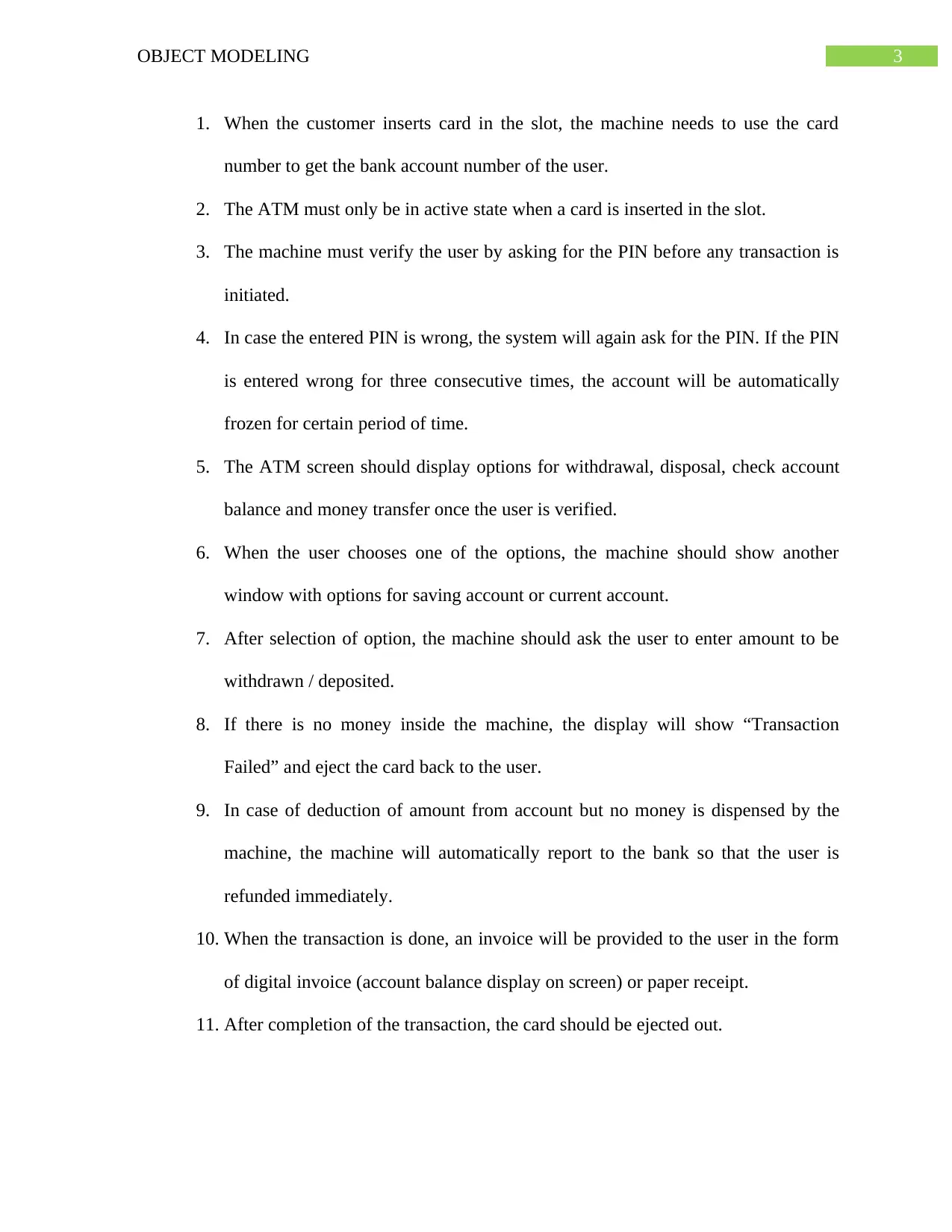
3OBJECT MODELING
1. When the customer inserts card in the slot, the machine needs to use the card
number to get the bank account number of the user.
2. The ATM must only be in active state when a card is inserted in the slot.
3. The machine must verify the user by asking for the PIN before any transaction is
initiated.
4. In case the entered PIN is wrong, the system will again ask for the PIN. If the PIN
is entered wrong for three consecutive times, the account will be automatically
frozen for certain period of time.
5. The ATM screen should display options for withdrawal, disposal, check account
balance and money transfer once the user is verified.
6. When the user chooses one of the options, the machine should show another
window with options for saving account or current account.
7. After selection of option, the machine should ask the user to enter amount to be
withdrawn / deposited.
8. If there is no money inside the machine, the display will show “Transaction
Failed” and eject the card back to the user.
9. In case of deduction of amount from account but no money is dispensed by the
machine, the machine will automatically report to the bank so that the user is
refunded immediately.
10. When the transaction is done, an invoice will be provided to the user in the form
of digital invoice (account balance display on screen) or paper receipt.
11. After completion of the transaction, the card should be ejected out.
1. When the customer inserts card in the slot, the machine needs to use the card
number to get the bank account number of the user.
2. The ATM must only be in active state when a card is inserted in the slot.
3. The machine must verify the user by asking for the PIN before any transaction is
initiated.
4. In case the entered PIN is wrong, the system will again ask for the PIN. If the PIN
is entered wrong for three consecutive times, the account will be automatically
frozen for certain period of time.
5. The ATM screen should display options for withdrawal, disposal, check account
balance and money transfer once the user is verified.
6. When the user chooses one of the options, the machine should show another
window with options for saving account or current account.
7. After selection of option, the machine should ask the user to enter amount to be
withdrawn / deposited.
8. If there is no money inside the machine, the display will show “Transaction
Failed” and eject the card back to the user.
9. In case of deduction of amount from account but no money is dispensed by the
machine, the machine will automatically report to the bank so that the user is
refunded immediately.
10. When the transaction is done, an invoice will be provided to the user in the form
of digital invoice (account balance display on screen) or paper receipt.
11. After completion of the transaction, the card should be ejected out.
Paraphrase This Document
Need a fresh take? Get an instant paraphrase of this document with our AI Paraphraser
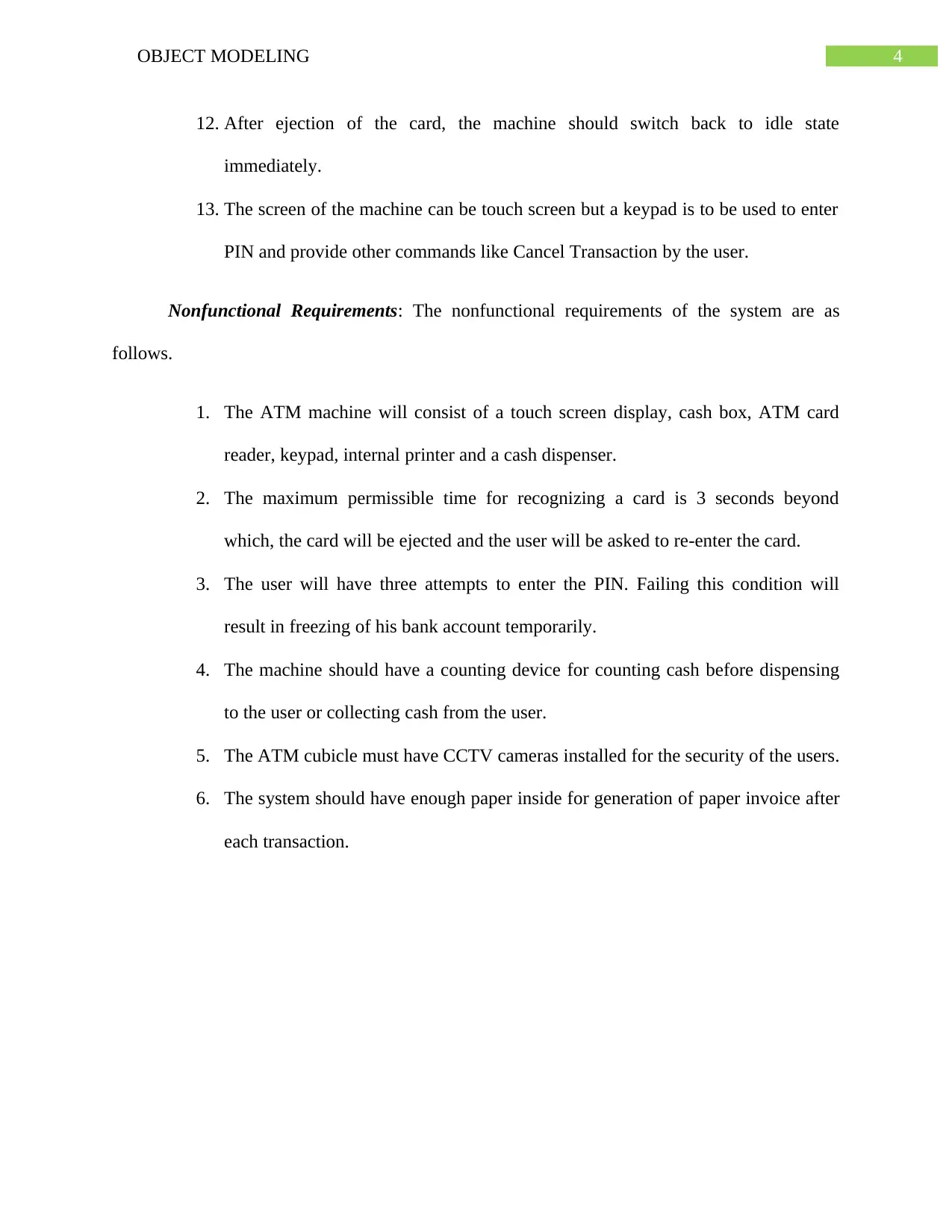
4OBJECT MODELING
12. After ejection of the card, the machine should switch back to idle state
immediately.
13. The screen of the machine can be touch screen but a keypad is to be used to enter
PIN and provide other commands like Cancel Transaction by the user.
Nonfunctional Requirements: The nonfunctional requirements of the system are as
follows.
1. The ATM machine will consist of a touch screen display, cash box, ATM card
reader, keypad, internal printer and a cash dispenser.
2. The maximum permissible time for recognizing a card is 3 seconds beyond
which, the card will be ejected and the user will be asked to re-enter the card.
3. The user will have three attempts to enter the PIN. Failing this condition will
result in freezing of his bank account temporarily.
4. The machine should have a counting device for counting cash before dispensing
to the user or collecting cash from the user.
5. The ATM cubicle must have CCTV cameras installed for the security of the users.
6. The system should have enough paper inside for generation of paper invoice after
each transaction.
12. After ejection of the card, the machine should switch back to idle state
immediately.
13. The screen of the machine can be touch screen but a keypad is to be used to enter
PIN and provide other commands like Cancel Transaction by the user.
Nonfunctional Requirements: The nonfunctional requirements of the system are as
follows.
1. The ATM machine will consist of a touch screen display, cash box, ATM card
reader, keypad, internal printer and a cash dispenser.
2. The maximum permissible time for recognizing a card is 3 seconds beyond
which, the card will be ejected and the user will be asked to re-enter the card.
3. The user will have three attempts to enter the PIN. Failing this condition will
result in freezing of his bank account temporarily.
4. The machine should have a counting device for counting cash before dispensing
to the user or collecting cash from the user.
5. The ATM cubicle must have CCTV cameras installed for the security of the users.
6. The system should have enough paper inside for generation of paper invoice after
each transaction.
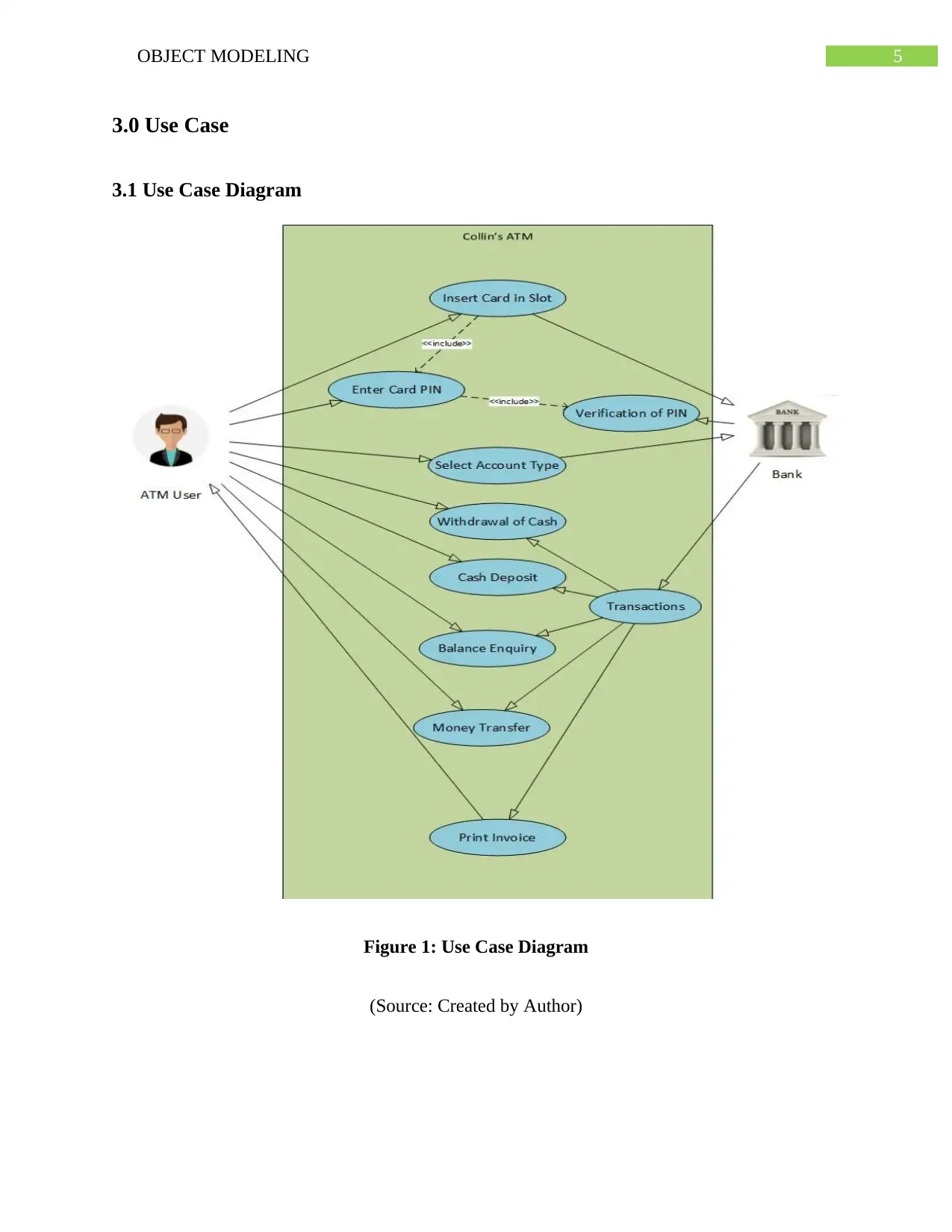
5OBJECT MODELING
3.0 Use Case
3.1 Use Case Diagram
Figure 1: Use Case Diagram
(Source: Created by Author)
3.0 Use Case
3.1 Use Case Diagram
Figure 1: Use Case Diagram
(Source: Created by Author)
⊘ This is a preview!⊘
Do you want full access?
Subscribe today to unlock all pages.

Trusted by 1+ million students worldwide
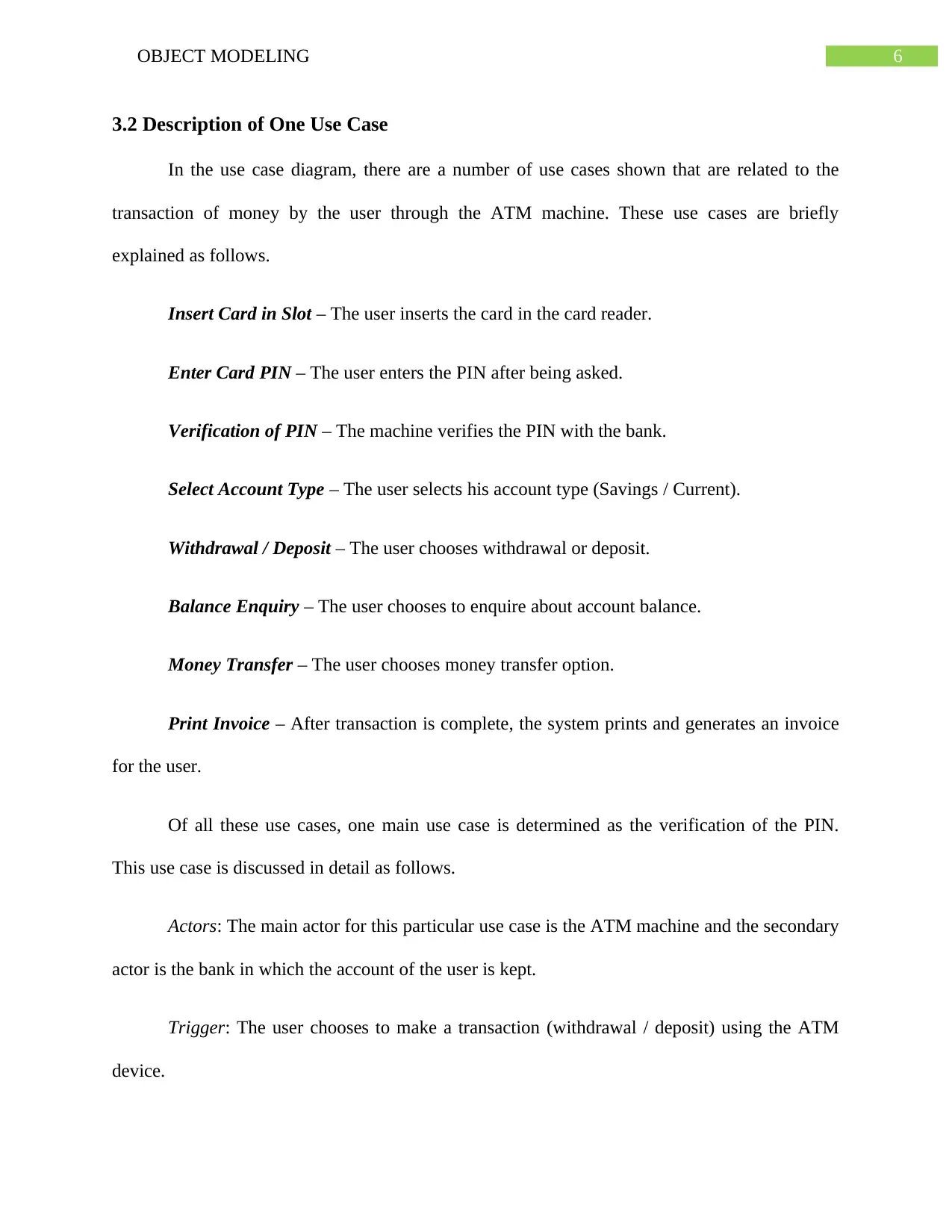
6OBJECT MODELING
3.2 Description of One Use Case
In the use case diagram, there are a number of use cases shown that are related to the
transaction of money by the user through the ATM machine. These use cases are briefly
explained as follows.
Insert Card in Slot – The user inserts the card in the card reader.
Enter Card PIN – The user enters the PIN after being asked.
Verification of PIN – The machine verifies the PIN with the bank.
Select Account Type – The user selects his account type (Savings / Current).
Withdrawal / Deposit – The user chooses withdrawal or deposit.
Balance Enquiry – The user chooses to enquire about account balance.
Money Transfer – The user chooses money transfer option.
Print Invoice – After transaction is complete, the system prints and generates an invoice
for the user.
Of all these use cases, one main use case is determined as the verification of the PIN.
This use case is discussed in detail as follows.
Actors: The main actor for this particular use case is the ATM machine and the secondary
actor is the bank in which the account of the user is kept.
Trigger: The user chooses to make a transaction (withdrawal / deposit) using the ATM
device.
3.2 Description of One Use Case
In the use case diagram, there are a number of use cases shown that are related to the
transaction of money by the user through the ATM machine. These use cases are briefly
explained as follows.
Insert Card in Slot – The user inserts the card in the card reader.
Enter Card PIN – The user enters the PIN after being asked.
Verification of PIN – The machine verifies the PIN with the bank.
Select Account Type – The user selects his account type (Savings / Current).
Withdrawal / Deposit – The user chooses withdrawal or deposit.
Balance Enquiry – The user chooses to enquire about account balance.
Money Transfer – The user chooses money transfer option.
Print Invoice – After transaction is complete, the system prints and generates an invoice
for the user.
Of all these use cases, one main use case is determined as the verification of the PIN.
This use case is discussed in detail as follows.
Actors: The main actor for this particular use case is the ATM machine and the secondary
actor is the bank in which the account of the user is kept.
Trigger: The user chooses to make a transaction (withdrawal / deposit) using the ATM
device.
Paraphrase This Document
Need a fresh take? Get an instant paraphrase of this document with our AI Paraphraser
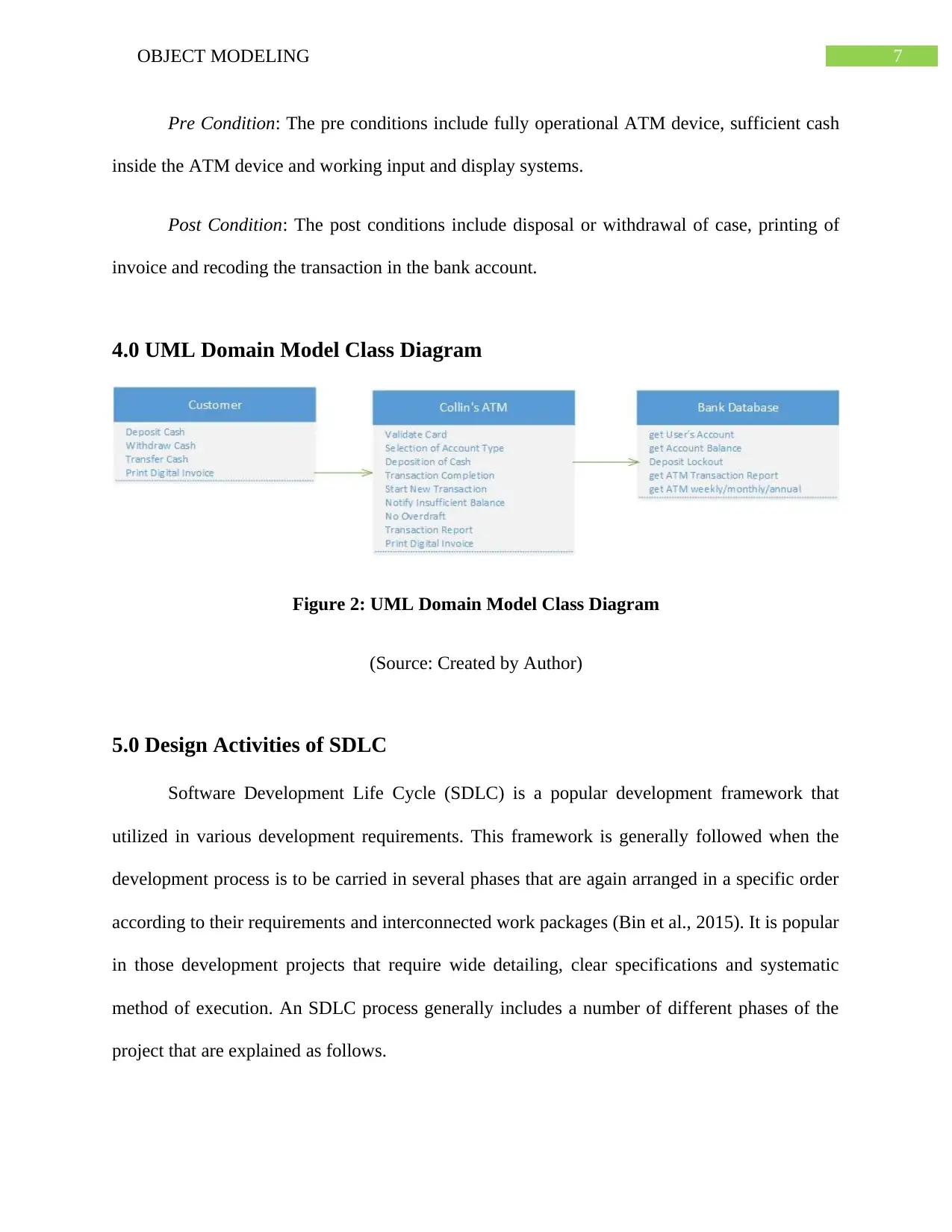
7OBJECT MODELING
Pre Condition: The pre conditions include fully operational ATM device, sufficient cash
inside the ATM device and working input and display systems.
Post Condition: The post conditions include disposal or withdrawal of case, printing of
invoice and recoding the transaction in the bank account.
4.0 UML Domain Model Class Diagram
Figure 2: UML Domain Model Class Diagram
(Source: Created by Author)
5.0 Design Activities of SDLC
Software Development Life Cycle (SDLC) is a popular development framework that
utilized in various development requirements. This framework is generally followed when the
development process is to be carried in several phases that are again arranged in a specific order
according to their requirements and interconnected work packages (Bin et al., 2015). It is popular
in those development projects that require wide detailing, clear specifications and systematic
method of execution. An SDLC process generally includes a number of different phases of the
project that are explained as follows.
Pre Condition: The pre conditions include fully operational ATM device, sufficient cash
inside the ATM device and working input and display systems.
Post Condition: The post conditions include disposal or withdrawal of case, printing of
invoice and recoding the transaction in the bank account.
4.0 UML Domain Model Class Diagram
Figure 2: UML Domain Model Class Diagram
(Source: Created by Author)
5.0 Design Activities of SDLC
Software Development Life Cycle (SDLC) is a popular development framework that
utilized in various development requirements. This framework is generally followed when the
development process is to be carried in several phases that are again arranged in a specific order
according to their requirements and interconnected work packages (Bin et al., 2015). It is popular
in those development projects that require wide detailing, clear specifications and systematic
method of execution. An SDLC process generally includes a number of different phases of the
project that are explained as follows.
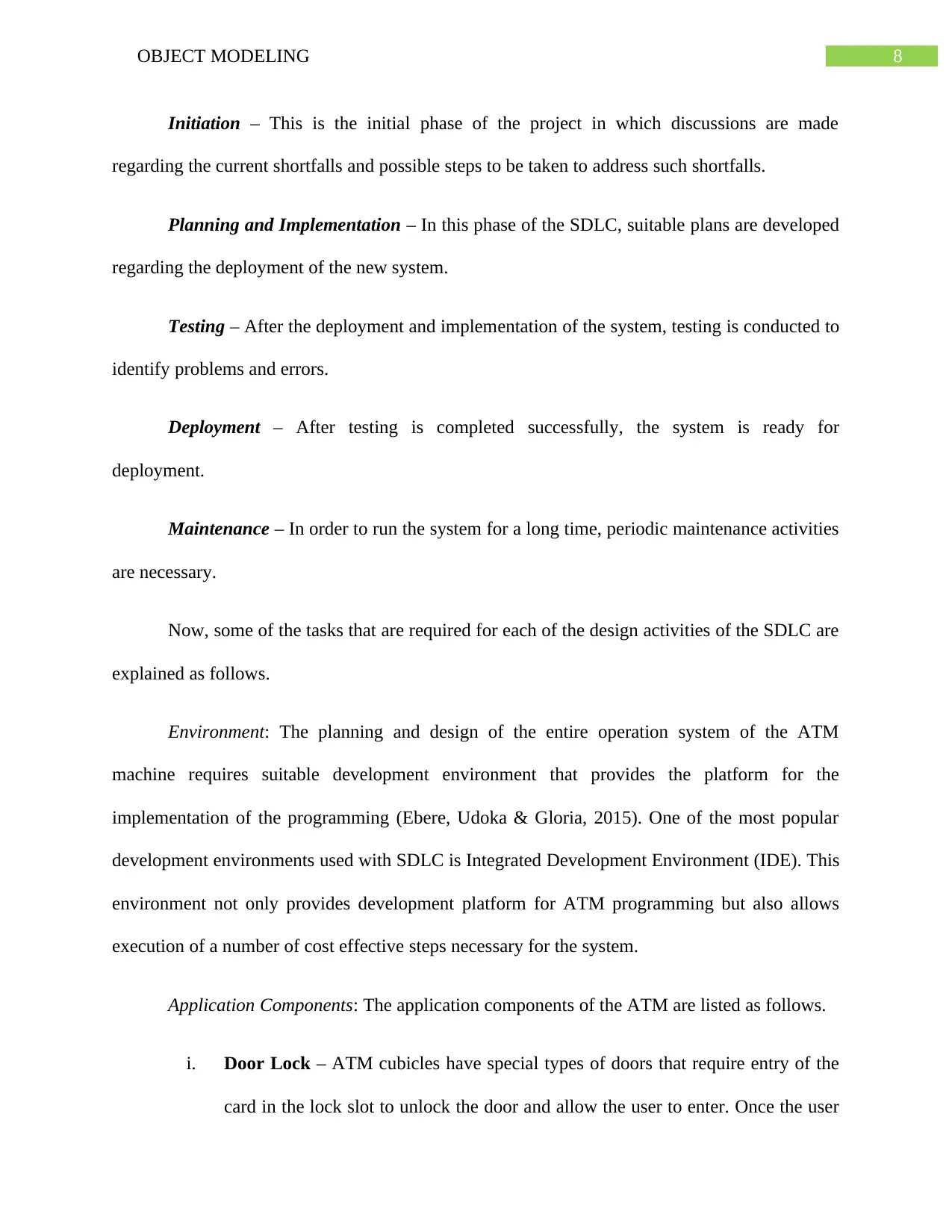
8OBJECT MODELING
Initiation – This is the initial phase of the project in which discussions are made
regarding the current shortfalls and possible steps to be taken to address such shortfalls.
Planning and Implementation – In this phase of the SDLC, suitable plans are developed
regarding the deployment of the new system.
Testing – After the deployment and implementation of the system, testing is conducted to
identify problems and errors.
Deployment – After testing is completed successfully, the system is ready for
deployment.
Maintenance – In order to run the system for a long time, periodic maintenance activities
are necessary.
Now, some of the tasks that are required for each of the design activities of the SDLC are
explained as follows.
Environment: The planning and design of the entire operation system of the ATM
machine requires suitable development environment that provides the platform for the
implementation of the programming (Ebere, Udoka & Gloria, 2015). One of the most popular
development environments used with SDLC is Integrated Development Environment (IDE). This
environment not only provides development platform for ATM programming but also allows
execution of a number of cost effective steps necessary for the system.
Application Components: The application components of the ATM are listed as follows.
i. Door Lock – ATM cubicles have special types of doors that require entry of the
card in the lock slot to unlock the door and allow the user to enter. Once the user
Initiation – This is the initial phase of the project in which discussions are made
regarding the current shortfalls and possible steps to be taken to address such shortfalls.
Planning and Implementation – In this phase of the SDLC, suitable plans are developed
regarding the deployment of the new system.
Testing – After the deployment and implementation of the system, testing is conducted to
identify problems and errors.
Deployment – After testing is completed successfully, the system is ready for
deployment.
Maintenance – In order to run the system for a long time, periodic maintenance activities
are necessary.
Now, some of the tasks that are required for each of the design activities of the SDLC are
explained as follows.
Environment: The planning and design of the entire operation system of the ATM
machine requires suitable development environment that provides the platform for the
implementation of the programming (Ebere, Udoka & Gloria, 2015). One of the most popular
development environments used with SDLC is Integrated Development Environment (IDE). This
environment not only provides development platform for ATM programming but also allows
execution of a number of cost effective steps necessary for the system.
Application Components: The application components of the ATM are listed as follows.
i. Door Lock – ATM cubicles have special types of doors that require entry of the
card in the lock slot to unlock the door and allow the user to enter. Once the user
⊘ This is a preview!⊘
Do you want full access?
Subscribe today to unlock all pages.

Trusted by 1+ million students worldwide
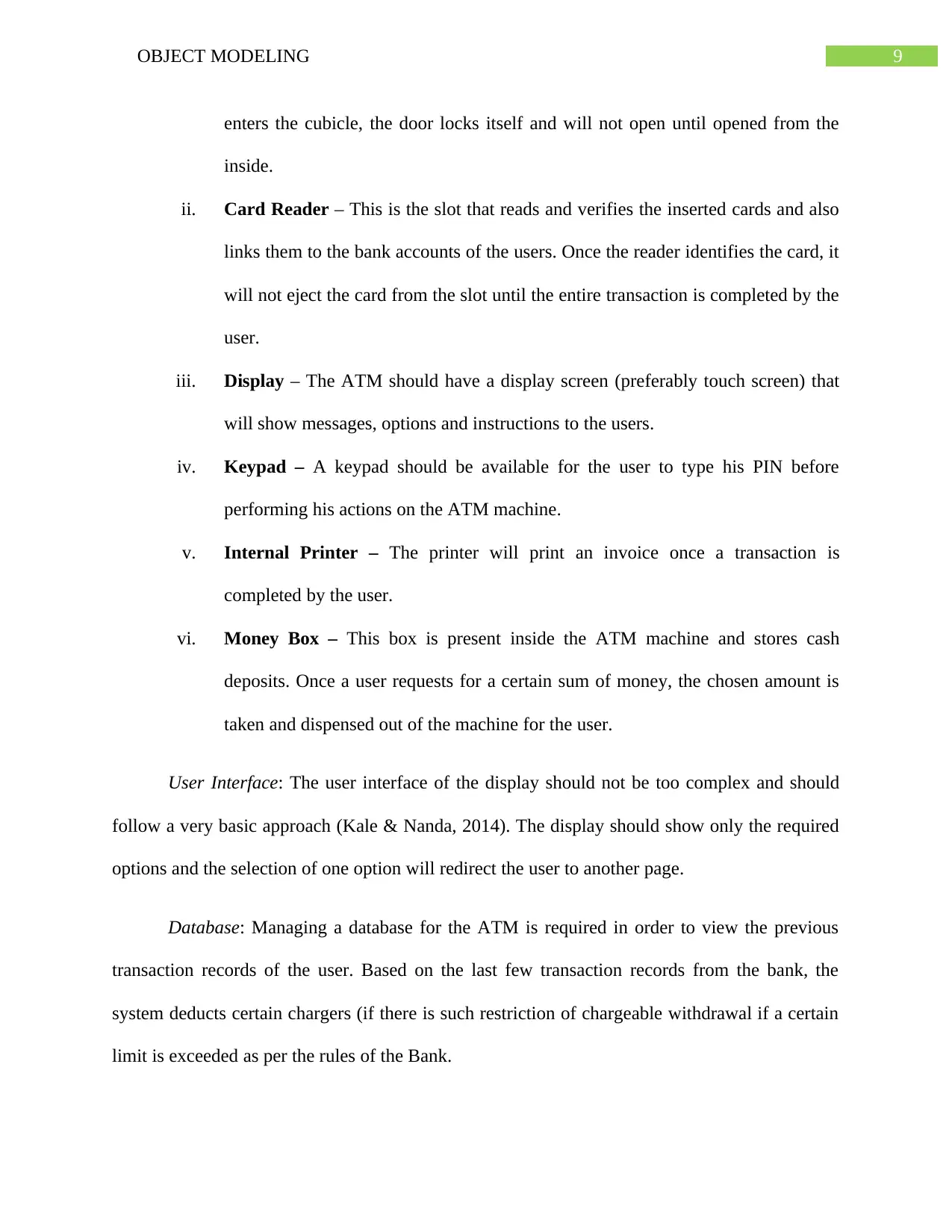
9OBJECT MODELING
enters the cubicle, the door locks itself and will not open until opened from the
inside.
ii. Card Reader – This is the slot that reads and verifies the inserted cards and also
links them to the bank accounts of the users. Once the reader identifies the card, it
will not eject the card from the slot until the entire transaction is completed by the
user.
iii. Display – The ATM should have a display screen (preferably touch screen) that
will show messages, options and instructions to the users.
iv. Keypad – A keypad should be available for the user to type his PIN before
performing his actions on the ATM machine.
v. Internal Printer – The printer will print an invoice once a transaction is
completed by the user.
vi. Money Box – This box is present inside the ATM machine and stores cash
deposits. Once a user requests for a certain sum of money, the chosen amount is
taken and dispensed out of the machine for the user.
User Interface: The user interface of the display should not be too complex and should
follow a very basic approach (Kale & Nanda, 2014). The display should show only the required
options and the selection of one option will redirect the user to another page.
Database: Managing a database for the ATM is required in order to view the previous
transaction records of the user. Based on the last few transaction records from the bank, the
system deducts certain chargers (if there is such restriction of chargeable withdrawal if a certain
limit is exceeded as per the rules of the Bank.
enters the cubicle, the door locks itself and will not open until opened from the
inside.
ii. Card Reader – This is the slot that reads and verifies the inserted cards and also
links them to the bank accounts of the users. Once the reader identifies the card, it
will not eject the card from the slot until the entire transaction is completed by the
user.
iii. Display – The ATM should have a display screen (preferably touch screen) that
will show messages, options and instructions to the users.
iv. Keypad – A keypad should be available for the user to type his PIN before
performing his actions on the ATM machine.
v. Internal Printer – The printer will print an invoice once a transaction is
completed by the user.
vi. Money Box – This box is present inside the ATM machine and stores cash
deposits. Once a user requests for a certain sum of money, the chosen amount is
taken and dispensed out of the machine for the user.
User Interface: The user interface of the display should not be too complex and should
follow a very basic approach (Kale & Nanda, 2014). The display should show only the required
options and the selection of one option will redirect the user to another page.
Database: Managing a database for the ATM is required in order to view the previous
transaction records of the user. Based on the last few transaction records from the bank, the
system deducts certain chargers (if there is such restriction of chargeable withdrawal if a certain
limit is exceeded as per the rules of the Bank.
Paraphrase This Document
Need a fresh take? Get an instant paraphrase of this document with our AI Paraphraser
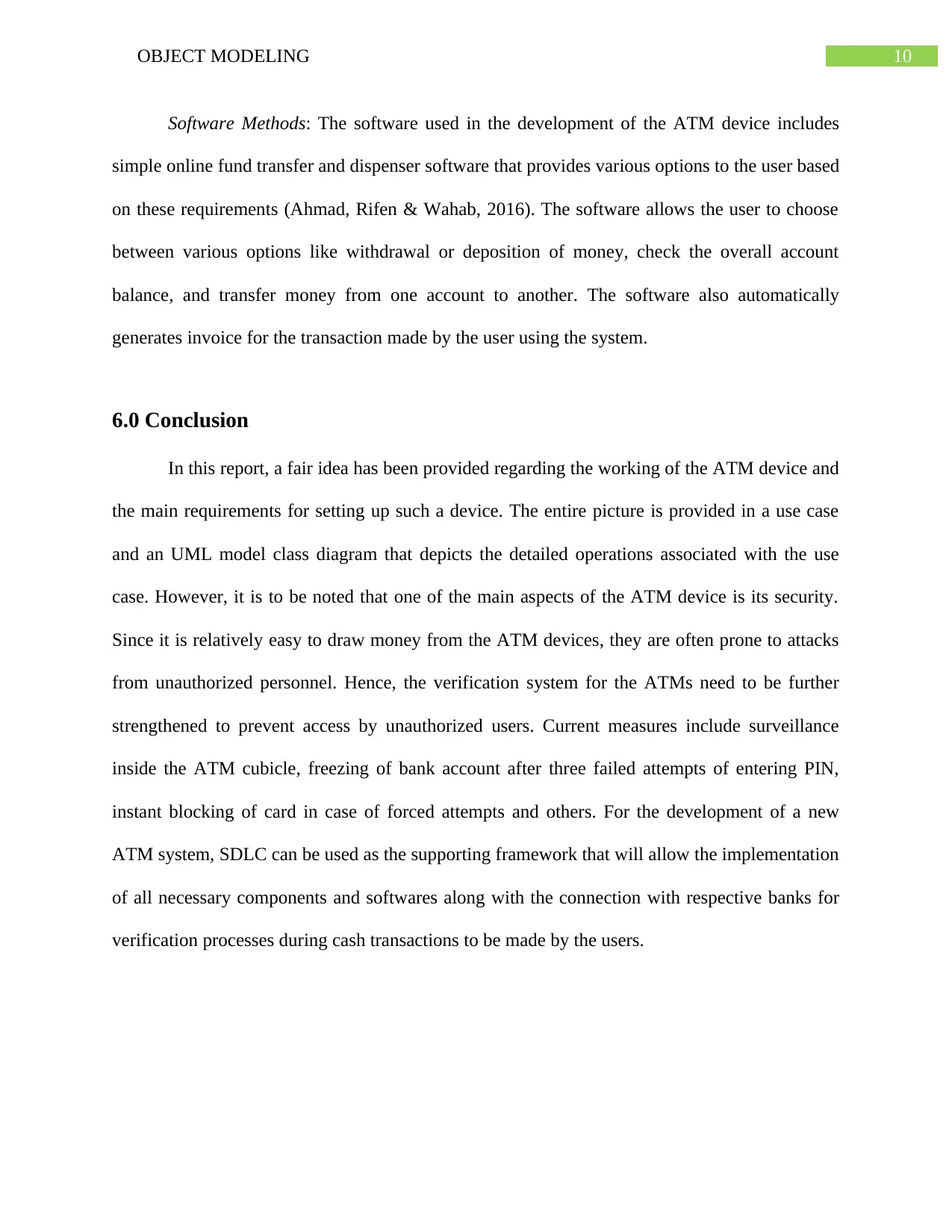
10OBJECT MODELING
Software Methods: The software used in the development of the ATM device includes
simple online fund transfer and dispenser software that provides various options to the user based
on these requirements (Ahmad, Rifen & Wahab, 2016). The software allows the user to choose
between various options like withdrawal or deposition of money, check the overall account
balance, and transfer money from one account to another. The software also automatically
generates invoice for the transaction made by the user using the system.
6.0 Conclusion
In this report, a fair idea has been provided regarding the working of the ATM device and
the main requirements for setting up such a device. The entire picture is provided in a use case
and an UML model class diagram that depicts the detailed operations associated with the use
case. However, it is to be noted that one of the main aspects of the ATM device is its security.
Since it is relatively easy to draw money from the ATM devices, they are often prone to attacks
from unauthorized personnel. Hence, the verification system for the ATMs need to be further
strengthened to prevent access by unauthorized users. Current measures include surveillance
inside the ATM cubicle, freezing of bank account after three failed attempts of entering PIN,
instant blocking of card in case of forced attempts and others. For the development of a new
ATM system, SDLC can be used as the supporting framework that will allow the implementation
of all necessary components and softwares along with the connection with respective banks for
verification processes during cash transactions to be made by the users.
Software Methods: The software used in the development of the ATM device includes
simple online fund transfer and dispenser software that provides various options to the user based
on these requirements (Ahmad, Rifen & Wahab, 2016). The software allows the user to choose
between various options like withdrawal or deposition of money, check the overall account
balance, and transfer money from one account to another. The software also automatically
generates invoice for the transaction made by the user using the system.
6.0 Conclusion
In this report, a fair idea has been provided regarding the working of the ATM device and
the main requirements for setting up such a device. The entire picture is provided in a use case
and an UML model class diagram that depicts the detailed operations associated with the use
case. However, it is to be noted that one of the main aspects of the ATM device is its security.
Since it is relatively easy to draw money from the ATM devices, they are often prone to attacks
from unauthorized personnel. Hence, the verification system for the ATMs need to be further
strengthened to prevent access by unauthorized users. Current measures include surveillance
inside the ATM cubicle, freezing of bank account after three failed attempts of entering PIN,
instant blocking of card in case of forced attempts and others. For the development of a new
ATM system, SDLC can be used as the supporting framework that will allow the implementation
of all necessary components and softwares along with the connection with respective banks for
verification processes during cash transactions to be made by the users.
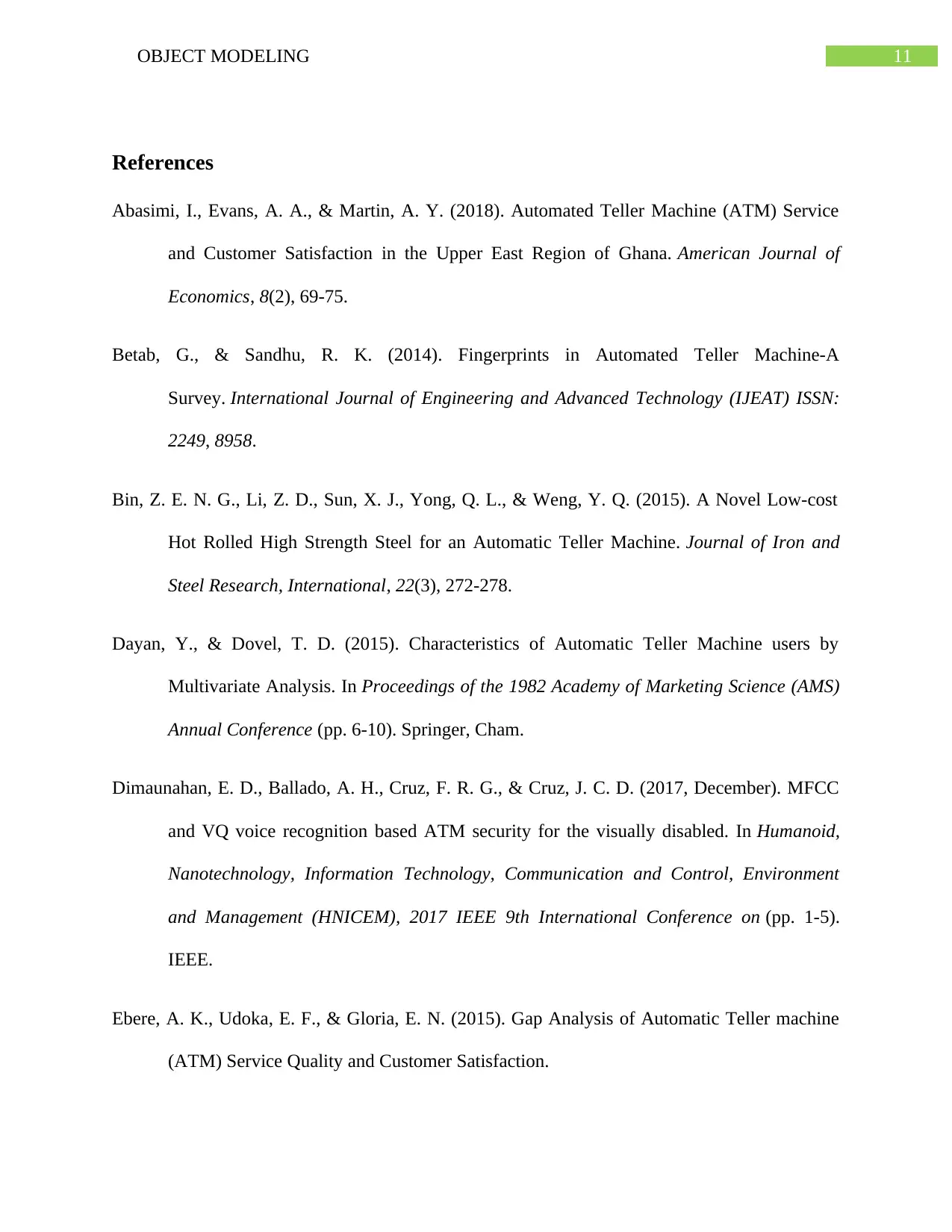
11OBJECT MODELING
References
Abasimi, I., Evans, A. A., & Martin, A. Y. (2018). Automated Teller Machine (ATM) Service
and Customer Satisfaction in the Upper East Region of Ghana. American Journal of
Economics, 8(2), 69-75.
Betab, G., & Sandhu, R. K. (2014). Fingerprints in Automated Teller Machine-A
Survey. International Journal of Engineering and Advanced Technology (IJEAT) ISSN:
2249, 8958.
Bin, Z. E. N. G., Li, Z. D., Sun, X. J., Yong, Q. L., & Weng, Y. Q. (2015). A Novel Low-cost
Hot Rolled High Strength Steel for an Automatic Teller Machine. Journal of Iron and
Steel Research, International, 22(3), 272-278.
Dayan, Y., & Dovel, T. D. (2015). Characteristics of Automatic Teller Machine users by
Multivariate Analysis. In Proceedings of the 1982 Academy of Marketing Science (AMS)
Annual Conference (pp. 6-10). Springer, Cham.
Dimaunahan, E. D., Ballado, A. H., Cruz, F. R. G., & Cruz, J. C. D. (2017, December). MFCC
and VQ voice recognition based ATM security for the visually disabled. In Humanoid,
Nanotechnology, Information Technology, Communication and Control, Environment
and Management (HNICEM), 2017 IEEE 9th International Conference on (pp. 1-5).
IEEE.
Ebere, A. K., Udoka, E. F., & Gloria, E. N. (2015). Gap Analysis of Automatic Teller machine
(ATM) Service Quality and Customer Satisfaction.
References
Abasimi, I., Evans, A. A., & Martin, A. Y. (2018). Automated Teller Machine (ATM) Service
and Customer Satisfaction in the Upper East Region of Ghana. American Journal of
Economics, 8(2), 69-75.
Betab, G., & Sandhu, R. K. (2014). Fingerprints in Automated Teller Machine-A
Survey. International Journal of Engineering and Advanced Technology (IJEAT) ISSN:
2249, 8958.
Bin, Z. E. N. G., Li, Z. D., Sun, X. J., Yong, Q. L., & Weng, Y. Q. (2015). A Novel Low-cost
Hot Rolled High Strength Steel for an Automatic Teller Machine. Journal of Iron and
Steel Research, International, 22(3), 272-278.
Dayan, Y., & Dovel, T. D. (2015). Characteristics of Automatic Teller Machine users by
Multivariate Analysis. In Proceedings of the 1982 Academy of Marketing Science (AMS)
Annual Conference (pp. 6-10). Springer, Cham.
Dimaunahan, E. D., Ballado, A. H., Cruz, F. R. G., & Cruz, J. C. D. (2017, December). MFCC
and VQ voice recognition based ATM security for the visually disabled. In Humanoid,
Nanotechnology, Information Technology, Communication and Control, Environment
and Management (HNICEM), 2017 IEEE 9th International Conference on (pp. 1-5).
IEEE.
Ebere, A. K., Udoka, E. F., & Gloria, E. N. (2015). Gap Analysis of Automatic Teller machine
(ATM) Service Quality and Customer Satisfaction.
⊘ This is a preview!⊘
Do you want full access?
Subscribe today to unlock all pages.

Trusted by 1+ million students worldwide
1 out of 15
Related Documents
Your All-in-One AI-Powered Toolkit for Academic Success.
+13062052269
info@desklib.com
Available 24*7 on WhatsApp / Email
![[object Object]](/_next/static/media/star-bottom.7253800d.svg)
Unlock your academic potential
Copyright © 2020–2025 A2Z Services. All Rights Reserved. Developed and managed by ZUCOL.




